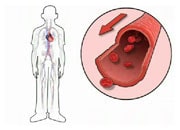Medical history and physical examination
The first thing a doctor will do if they suspect you have heart failure is take your medical history and carry out a thorough examination of your body. This is important to identify your current symptoms, but also to try to identify the possible cause of your heart failure. During a medical history and physical examination your doctor will ask you about symptoms, recent or past illnesses, physical activity, breathing, sleeping, eating and other activities. Once the doctor has completed your medical history, he or she will carry out a physical examination. The parts of the physical examination that are most helpful in diagnosing heart failure are:
- Measuring your blood pressure and pulse. High blood pressure puts extra stress on the heart and a fast and/or irregular heart rate could indicate the heart is trying to pump faster to compensate.
- Assessing skin colour and warmth.
- Checking the veins in your neck. If blood is backing up in your heart, the veins in your neck may swell or bulge.
- Listening to your breathing and heart with a stethoscope. A crackling sound on the lungs or wheezing may indicate fluid accumulation in the lungs. Abnormal heart sounds (murmurs) can reveal valve defects.
- Checking your abdomen for swelling caused by fluid accumulation.
- Checking your ankles and legs for swelling caused by fluid accumulation.
- Measuring your body weight.





















